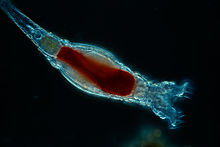Syndermata
This article needs additional citations for verification. (June 2022) |
| Syndermata | |
|---|---|

| |
| Rotifer | |

| |
| Acanthocephalan | |
| Scientific classification (disputed) | |
| Domain: | Eukaryota |
| Kingdom: | Animalia |
| Clade: | Gnathifera |
| Clade: | Syndermata Zrzavý, 1998 |
| Phyla | |
Syndermata is a clade of animals that, in some systems, is considered synonymous with Rotifera. Older systems separate Rotifera and Acanthocephala as different phyla, and group them both under Syndermata. This clade is placed in the Platyzoa.
Phylogeny
Phylogenetic analysis of the 18S ribosomal gene has revealed that the Acanthocephala, formerly considered a separate phylum are most closely related to the rotifers. They are possibly closer to the two rotifer classes Bdelloidea and Monogononta than to the other class, Seisonidea, producing the names and relationships shown in the cladogram below.[citation needed]
A study of the gene order in the mitochondria suggests that Seisonidea and Acanthocephala are sister clades and that the Bdelloidea are the sister clade to this group.
References
- ^ Ruppert, Edward E.; Fox, Richard S.; Barnes, Robert D. (2004), Invertebrate Zoology : a functional evolutionary approach (7th ed.), Belmont, CA: Thomson-Brooks/Cole, ISBN 978-0-03-025982-1, p. 788ff. – see particularly p. 804
- ^ Perrot-Minnot, Marie-Jeanne; Cozzarolo, Camille-Sophie; Amin, Omar; Barčák, Daniel; Bauer, Alexandre; Filipović Marijić, Vlatka; García-Varela, Martín; Servando Hernández-Orts, Jesús; Yen Le, T.T.; Nachev, Milen; Orosová, Martina; Rigaud, Thierry; Šariri, Sara; Wattier, Rémi; Reyda, Florian; Sures, Bernd (2023). "Hooking the scientific community on thorny-headed worms: interesting and exciting facts, knowledge gaps and perspectives for research directions on Acanthocephala". Parasite. 30: 23. doi:10.1051/parasite/2023026. PMC 10288976. PMID 37350678.

- ^ "Syndermata". comenius.susqu.edu. Retrieved 2022-06-06.
- ^ Sielaff, M.; Schmidt, H.; Struck, T. H.; Rosenkranz, D.; Mark Welch, D. B.; Hankeln, T; Herlyn, H. (March 2016). "Phylogeny of Syndermata (syn. Rotifera): Mitochondrial gene order verifies epizoic Seisonidea as sister to endoparasitic Acanthocephala within monophyletic Hemirotifera". Molecular Phylogenetics and Evolution. 96: 79–92. doi:10.1016/j.ympev.2015.11.017. PMID 26702959.